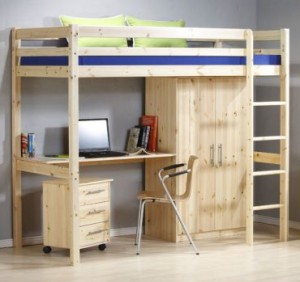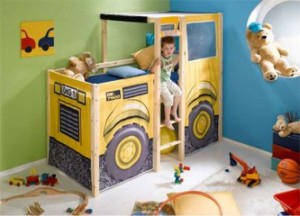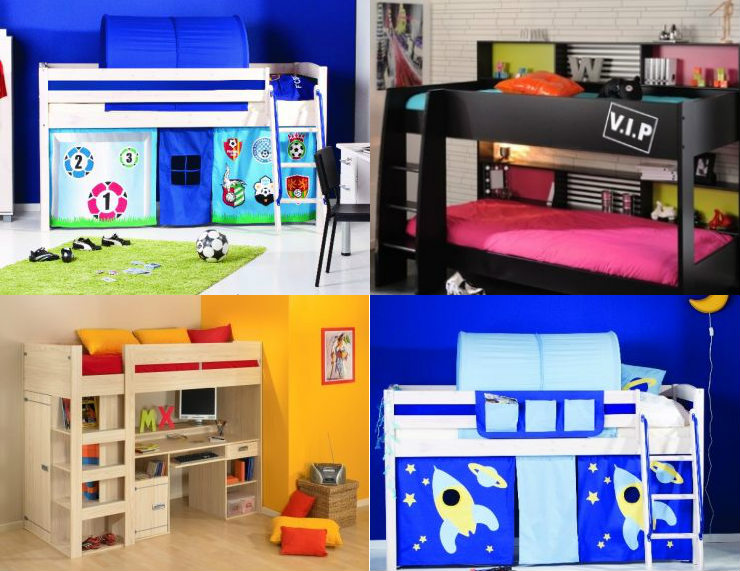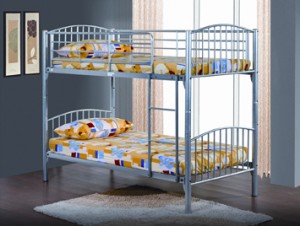Read our free guide to the different types of kids beds.
Contents
- Types of Kids Beds
- Standard Bunk Beds
- Futon Bunk Beds
- Loft Beds
- Bookcase Beds
- Cabin Beds
- Captain’s/Children’s Beds
- Junior/Novelty Beds
- Useful Resources
Types of Kids Beds
When coming to purchase a bed for your child then consider all the different options on the market before committing to buy. Kid’s beds will come in a range of styles and shapes, some being more suitable than others for the existing style of the bedroom or child’s preference.
It is imperative to plan carefully when coming to make a final decision; take into consideration the size dimensions of where the bed is being positioned along with the height of the child. Also think of their age and growing potential to guarantee a shrewd purchase in the long run.
Keeping in line with a set budget is also important to avoid overspending. Trying to cut costs with the purchase is not advisable however as an inadequate bed can affect your child’s sleep and posture. Sleep specialists advise to buy the best you can afford.
The different types of beds available for children are detailed below:
Standard Bunk Beds
One of the most recognisable and common models of children’s beds are bunk beds. Traditionally, they consist of one frame stacked on top of the other, with access to the top mattress attained by using a ladder.
Bunk beds are fantastic for saving space as they minimise the dimensions that two separate beds will require. They are a perfect alternative for younger children who may be sharing a room. The vast majority of bunk beds are commonly made from strong woods or steel to provide the extra support needed to hold two bodies at the same time.
There are some safety concerns for parents with smaller children however. These include the possibility of them falling out of the top bunk and also the accessibility of the ladder. Look for bunk beds with manageable, secure ladders and elevated railings for peace of mind.
Futon Bunk Beds
Futon bunk beds are similar to standard models but integrate a futon sofa underneath the top mattress. They offer children a handy place to sit so they can read, play computer games and watch TV without messing up the bed or spilling unwanted food/drink in the sleeping area.
Like traditional bunk beds, they require the child to climb a ladder to reach the top bed but do provide extra space in a room. For smaller bedrooms they can be extremely useful for parents when planning a layout.
Futon bunk beds can also include additional storage for clothes, toys, bedding and other items. In addition, the futon of some models can be opened up to provide an additional sleeping area if needed.
Loft Beds
Similar to the design of bunk beds, loft beds have an elevated frame for the top mattress to lie on but no bottom bunk. This leaves additional storage space beneath for chests, drawers, and wardrobes to be positioned.
If your child is at an age where they can use a computer or need to complete homework then desks are also a popular fitting in the area vacated by the absent bottom bunk. The appealing nature of these loft beds can help attract some children to use it as a workstation.
Bookcase Beds
 For increased storage underneath a bed, bookcase models have plenty of drawers and shelves included in the frame. They are ostensibly used for keeping books inside, as their name suggests, but also for any other items as desired.
For increased storage underneath a bed, bookcase models have plenty of drawers and shelves included in the frame. They are ostensibly used for keeping books inside, as their name suggests, but also for any other items as desired.
They are a conventional type of bed but again, like bunk beds, have the advantage of providing additional space for smaller rooms. Additional shelves can also be built into the headboard where items such as alarm clocks, radios and pictures frames can all be placed in a reachable position.
Cabin Beds
Popular with younger children and teenagers alike, the cabin bed is defined with its elevated frame and its potential for many additional accessories to be attached. The different parts of the bed are manufactured from a variety of different materials, commonly wood, steel and aluminium.
The height of the frame and mattress can alter, usually from around 2 feet up to around 6 feet, making them suitable for children of all ages and heights. Ladders can be used to climb onto the top of taller cabin beds.
Some of the accessories in cabin beds include top tunnels – this allows the child to close-up the extra material over their head, keeping out sunlight and promoting a longer sleep. Bunk lights are also useful to encourage a child to read without needing to turn on and off the main light switch.
Captain’s/Children’s Beds
Captain’s or children’s beds come in the same format as conventional models but are smaller in width and length. They are predominantly constructed from wood and include storage space underneath the mattress. Large headboards and a friendly appearance is usually a trademark of a children’s bed.
Because of the additional compartments underneath the lying surface, some captain’s beds are only suitable for taller children who can climb on top of the elevated mattress. Some models have an additional pull out bed beneath also, providing perfect accommodation when your child invites a friend for a sleep-over.
Junior/Novelty Beds
 For younger children, the exterior of the bed may be the most important aspect to them. An attractive bed can even entice them into sleeping more willingly, making the frequently difficult and potentially gruelling bedtime ritual easier for some parents.
For younger children, the exterior of the bed may be the most important aspect to them. An attractive bed can even entice them into sleeping more willingly, making the frequently difficult and potentially gruelling bedtime ritual easier for some parents.
In this sense, look out for colourful beds or those with famous cartoon characters portrayed on them for example. Other models can be purchased that have a certain theme which the child has an interest in; football or motor racing beds can suit young boys whilst pink or Barbie themed beds will be more appropriate for girls.
If looking to invest in a bunk bed, look out for novelty features to increase the fun level associated with going to sleep. Slides are an appealing feature on some versions, providing an enjoyable way to reach the floor from the top bunk. Also, the space vacated underneath loft beds can be turned into a den-type area, with tents or curtains providing privacy for creative children.
Because of the wide selection of kid’s beds available on the market, choosing the perfect type for your child’s bedroom is achievable for parents on any budget.
Check the size dimensions of where the bed will be positioned, using a tape measure to make sure of the specific length, height and width required. Ensure that easy and safe access is achievable in proximity to other bedroom furniture also. If the bed is to be placed against a wall look to see if drawers, shelves and ladders are positioned on the appropriate side of the bed for a suitable way in.
Useful Resources
A list of useful sites for anyone looking for more information on or to buy kids beds in the UK:


